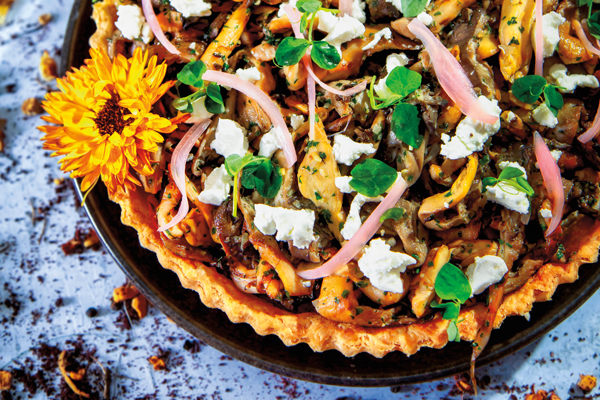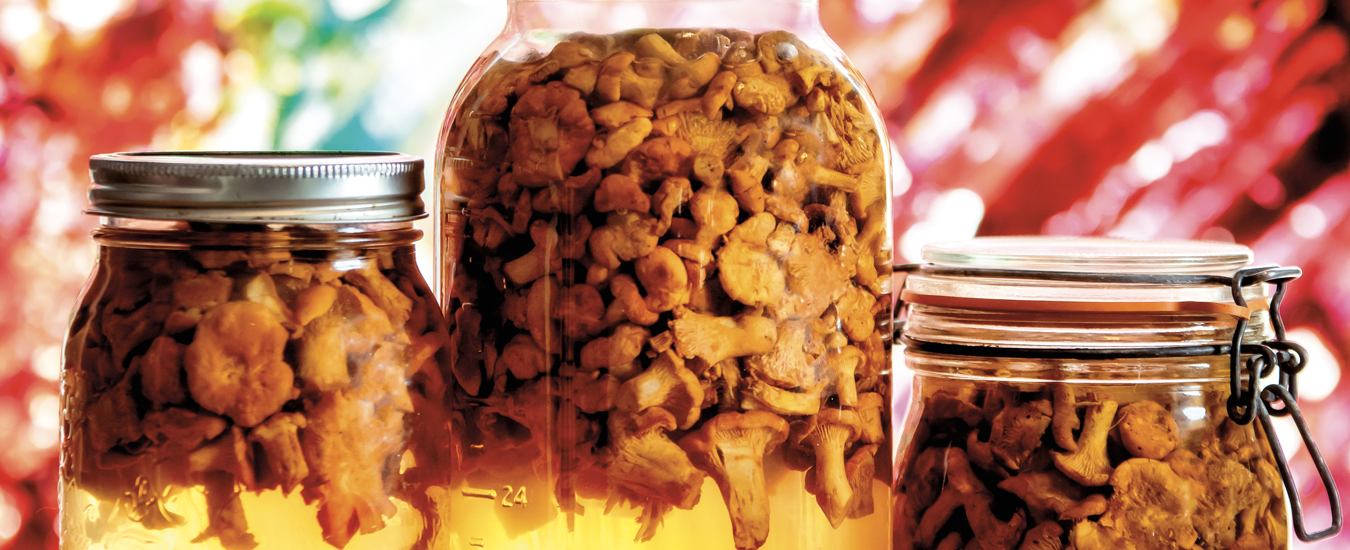As evening temperatures drop and fall rain settles in, magic happens beneath a canopy of spruce, fir, and oak, and the mushroom season in Atlantic Canada begins to flourish. Puffballs, lion’s mane, hen-of-the-woods, matsutake; beautiful to look at and poetically named, and the forest floor is a veritable feast for a few weeks.
Resembling icicles, cauliflowers, soccer balls, and human brains, they arise from beneath carpets of green moss, sprouting from tree trunks and protruding from dead logs. Some turn bright blue or red when bruised, others glow in the dark. It’s the busiest season for foragers, which means mycological maestros are out from sunrise to sunset, traversing one end of the province to the other in search of fungi. With more than 2,000 varieties and more than 50 types of edible mushrooms, Atlantic Canada is a mycological paradise because of its diversity of microclimates, topography, and tree species.
The early, delicious fall beauties are chanterelles. The gold standard for most mushroom hunters is their distinctively peachy-apricot smell and furled, fleshy golden caps. The mushrooms are the fruit that spring from an underground web of mycelium, and if the mycelium survives, chanterelles return every year. Too much foot traffic can break the web and over-harvesting can reduce the chances the mushrooms have to spread to new places.
Chanterelles are gregarious and grow in clusters, but always in the presence of living trees, forming a symbiotic relationship. The mushrooms draw sugar and carbohydrates from the trees’ younger roots and provide phosphorus and minerals. Despite the best efforts to cultivate chanterelles, foragers still hand-pick them in the woods, which is also why they’re so expensive and popular with chefs.
Mushrooms have unique ecological preferences, whether their relationship with a particular tree species, type of moss, type of substrate, or their proximity to fresh or salt water. Understanding these intricate factors, what to look for, and how to predict where a particular species might be growing in abundance takes years of learning and practice.

Fred Dardenne, of Halifax-based FD Wildfoods, learned to forage for mushrooms as a young boy from his grandfather, growing up in the forests of Belgium. A master of his craft, autumn is a hectic and busy season, as he picks hundreds of kilograms of mushrooms in a day, shipping them to chefs from Halifax to Montreal. The species Dardenne picks depends on certain trees and habitats and can’t be cultivated. Wild fungi require foraging, and Dardenne picks both popular and rare species, including lobsters, blue chanterelles, and matsutake.
“Nothing smells as good as this,” says Dardenne, holding out a giant, white matsutake mushroom. Mycologist David Arora described them as “a provocative compromise between Red Hots and dirty socks.”
“When matsutakes are young, they are almost completely buried underneath the moss,” says Dardenne. “You have to look for small bumps in the moss and pat around with your hands to feel for them.” Matsutakes require more careful picking and handling than any other species because their value is determined on a graded scale. If sold to the Japanese market, they use several observable characteristics, like the veil and the completely intact base.
The popularity of foraging for fungi grows each year, but it’s essential to know your stuff. Just as there’s nothing quite like freshly made risotto ai funghi, there’s nothing like discovering your face bloating like a balloon. Although few wild mushrooms are deadly, the hazards are more likely to range from an extreme laxative effect to kidney failure.
Their presence is fleeting. September and October are typically when the highest diversity of mushrooms is out in the wild, so now is the time to gather your baskets and head into the woods. You’ll need a sharp eye, a delicate touch, and an intense nose as you search for fleshy fungi. The fun is as much in the search as in finding the treasure.
5 wild edible mushrooms
Hen of the Woods: Also known as sulphur shelf, this distinctive mushroom usually grows in abundance in stands of old oak trees. The bigger the oaks, the better chance you will find mushrooms. They grow on the ground near the base but can also be found within a couple metres of the tree. They are delicious in various ways, including sliced and pan-fried, diced for mushroom soup, or battered and deep-fried.
Puffball: If you spot what looks like a white ball in the woods, it’s likely a puffball. Typically 20 to 25 centimetres across, puffballs have no stem and lay directly on the ground. Confirm edibility by cutting the mushroom in half from top to bottom. The inside should be pure, featureless white. Discard if it’s darker.
Lion’s Mane: A striking white ball that grows on a dead log and might be overlooked by everyone except a mushroom forager. This beauty has branches that are adorned with white icicles. It is delicious when sauteed in olive oil or added to eggs or a vegetable stir fry.
Porcini: The name porcini means “piglets” in Italian. They’re also known as the king bolete, cèpe (in French), and steinpilz (the “stone mushroom” in German). Porcini mushrooms can grow a rather large cap, up to 20 centimetres in diameter and are usually brown or reddish with a thick stem and slightly sticky texture. You can find porcini mushrooms on the ground in hardwood and softwood forests throughout the region. Delicious chopped and sauteed with fresh thyme.
Hedgehog: Perhaps the easiest of all wild mushrooms to identify. Its yellow/orange cap and fruity smell resemble chanterelles, but its toothlike underbelly distinguishes it. The rich, earthy flavour makes it a great addition to stews and casseroles.

Safe mushrooming
- Always cook wild mushrooms before eating.
- Never sample a raw wild mushroom.
- Join organizations such as the Nova Scotia Mycological Association, where you’ll learn from experts.
- Purchase a reliable mushroom foraging book with photos.
- When in doubt, throw it out. Only eat a wild mushroom if you are sure of its identity.
Recipes
Recipes and styling by Chef Greg Burns.
